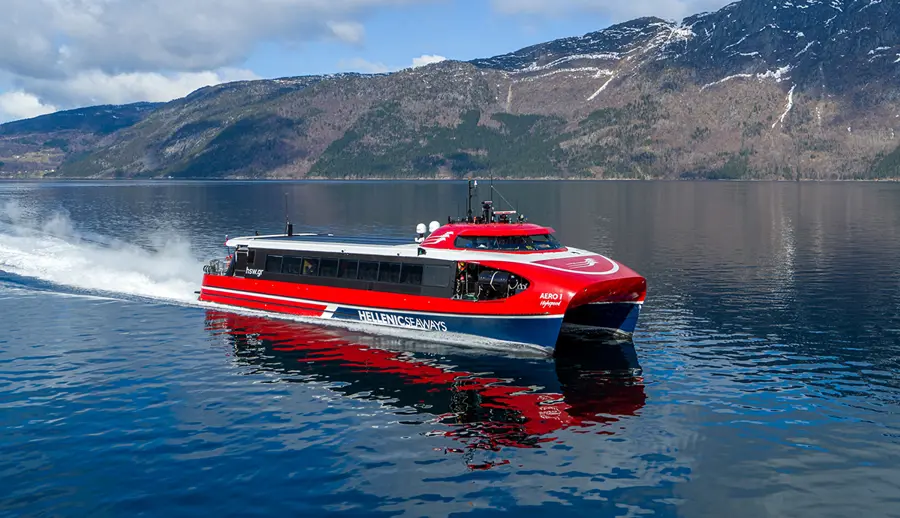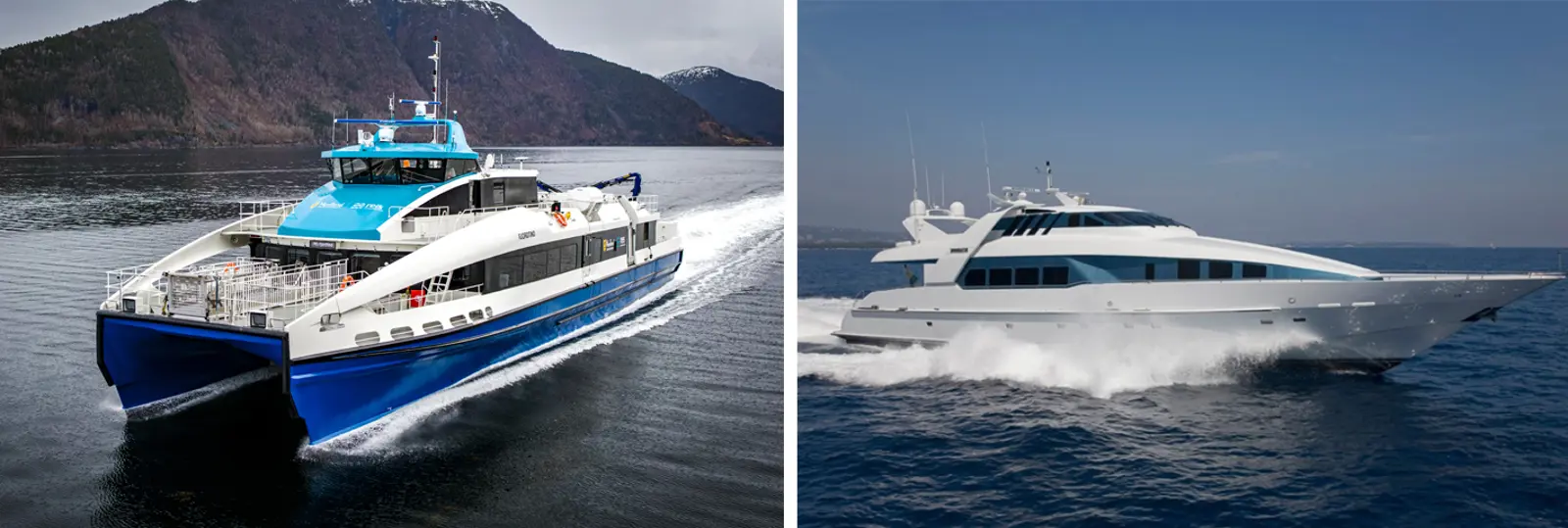

Brødrene AA was founded in 1947. The shipyard was named after brothers (Brødrene) Olav Aa (1920-2006) and Bertel Aa (1919-2009) and has now become the world leader in the construction of energy efficient fast ferries made of carbon fibre composites.
Brødrene AA, renowned for its commitment to efficiency and innovation, and Diab, experts in advanced foam solutions and lightweight composites, are today celebrating a collaboration that has thrived for over 50 years.
Initially, the shipyard worked solely with wood, crafting mahogany and other timbers to create leisure boats and then small passenger ferries. In 1974, following the launch of the lightweight, non-metallic GRP minesweeper HSwMS Viksten by Saab Kockums, Brødrene AA began to work with composites,exploring foam sandwich production with Diab PVC cores. This early pioneering work saw Brødrene AA complete its first foam cored ferry in 1975. The Haaen was delivered to Haaland & Sønn in Stavanger, making it the first foam sandwich passenger vessel to be approved by the Norwegian Maritime Directorate. In 1979, the shipyard reinforced the switch to composite construction by launching the 85 foot catamaran Hyen. This ship, that still operates today in Iceland, represented another key milestone, combining its Norwegian Maritime certification with class approval by DNV, another world first for Brødrene AA.
The performance, strength and durability of these lightweight vessels captured market interest and the shipyard thrived, developing multiple Surface Effect Ships (SES) that ride smoothly on a cushion of air
at speeds of close to 50 knots. Brødrene AA pushed the technical performance of GRP construction to the limit with the build of Moonraker in 1992, a 36m Mulder designed superyacht powered by twin MTU engines and a single gas turbine. The lightweight, Diab cored hull and superstructure, combined with an optimised hull shape and tunable trim tabs, delivered an impressive top speed of 66.7 knots, making her the world’s fastest megayacht.

Having completed several more superyacht builds in the 1990s and transferred their composite manufacturing expertise to components for the rail and subsea sectors, Brødrene AA saw an opportunity to further reduce vessel weight with an infused carbon reinforced sandwich structure. With a wellengineered carbon and foam sandwich construction, carefully infused with vinylester resins to create
a hull, deck, and internal structure with the perfect resin to fibre ratio, weight savings of 30-40% are achievable versus aluminium structures.
Brødrene AA capitalized on this weight reduction, creating low maintenance vessels that offered fuel consumption reductions of up to 40% compared to similar aluminium ships. Infused sandwich
construction with carbon fibre and Diab PVC has become the standard build method for the shipyard’s fast ferries. Brødrene AA has launched around eighty vessels to date with another ten fully electric and
hybrid craft under construction now.
Diab foam cores have played an important role as Brødrene AA continues to optimize its vessel design and production techniques. “Our engineers have worked consistently to improve the performance
of the foam throughout our partnership with Brødrene,” explains Viggo Karlsen, Managing Director, Diab Norway. “Supplying tightly toleranced thicknesses that create the smoothest laminates and evolving their flow and form-based finishes to save production cost, improve infusion times and reduce component weight.”
Brødrene AA’s engineering and design teams have also pioneered some of the most novel fast ferry and sightseeing vessel designs. From the efficient, single-deck, high-speed AERO designs that were
launched in 2022 for the Greek operator Attica Group to the iconic trio of ramp decked Seasight designs Vision, Future and Legacy of the Fjords, the shipyard leads the way in innovative styling and functionality development.
“A key moment during our 50 years of working together was in 2017, when Brødrene, Diab and partners Reichhold and Saertex received a JEC Innovation Award for the design and construction expertise of
the new Seasight hybrid-electric tour vessel Vision of the Fjords,” said Karlsen. “This unique new 100% electric, zero emission design was recognized by SKIPSREVYEN as Ship of the Year 2016 and received
a whole host of awards including the Shippax Award 2017 and Category Winner Innovation Award for Universal Design 2017, plus the DOGA Award for Design and Architecture 2017.”
Many of the vessels built at Brødrene AA represent new or modified designs based on customer requirements, with this design evolution making standardisation and kitting of foam sections complex.
Despite the challenges, both companies are currently working on a kit development initiative that Diab believes will not only speed up the foam positioning but will also significantly reduce overall costs at
Brødrene AA.
Both Brødrene AA and Diab recognize that a key factor in reducing their overall environmental impact is their ability to improve their product’s circularity, from product design, through the production stage,
and considering the complete product lifecycle. Diab takes a leading market position with Karlsen confirming, “We have worked quickly with the Science Based Targets Initiative to reduce the carbon footprint of our materials by 50% between 2016 and 2023 (from 11 kg CO2e/ kg to 5.6 kg CO2e/ kg) by focusing on changes in material, processing techniques, waste control and updated energy sources.”
Brødrene AA takes the view that using carbon fibre and foam in their builds is a more sustainable choice simply because of their vessels’ longevity. One of the most notable outcomes of this partnership is the
exceptional long-term lifespan of the ferries. Despite decades of service, all vessels built by Brødrene AA remain in operation today. This underscores both the durability and resilience of the materials,
minimizing the need for vessel replacement and reducing overall lifecycle costs for their operators. Unlike aluminium craft that can become overweight and expensive to maintain after two or three decades of service, foam composite vessels keep performing and can now be refitted to take advantage of greener propulsion options.
Brødrene AA is currently working on a unique project at its Eikefjord refit yard, with two existing ferries MS Baronessen and MS Baronen returning for a hull extension and a switch to battery power.
Diab cores will be used for the ten metre hull upgrades that will also allow the vessels to use SHIFTR battery replacement technology developed by Norled. These vessels will be the first to operate with the
autonomous robotic SHIFTR solution, whereby battery packs can be swapped in less than five minutes, maintaining operational efficiency, and allowing batteries to be slowly charged without overloading the
grid system. Switching from internal combustion power to zero-emission electric drives increases the vessel weight, with the shipyard overseeing the hull modifications that will maintain seaworthiness and
match operator speed and range requirements. Refitting existing vessels, and switching to electrified drive systems, as opposed to building new vessels, is a testament to the circular design concept
developed by Brødrene AA, enabling older ships to perfectly match their future operational targets and the shipping industry’s environmental targets.
Brødrene AA has delivered a stunning portfolio of high-speed vessels throughout its history. Most of these craft, along with composite structures developed for additional market sectors such as sub-sea
and rail, have featured lightweight cores from Diab.
“As we commemorate 50 years of collaboration with Diab, we reflect not only on our shared history but also on what lies ahead. Together, we’ve sailed through challenges, harnessed new composite technologies, and navigated the seas of change,” said Tor Øyvin Aa, CEO, Brødrene AA. “As we take on the next half-century, our partnership with Diab remains steadfast and it drives us forward as we pioneer the development of the lightest, cleanest, high-performance ships of the future.”
“The enduring partnership between Diab and Brødrene AA demonstrates the power of our technical collaboration and innovation in delivering performance benefits and driving sustainability within the
maritime industry,” concludes Karlsen. “Through the adoption of circular design solutions and the relentless pursuit of lightweight, durable materials we have achieved great success, delivering massive
weight savings for Brødrene AA and its customers whilst also minimizing environmental impact.”
